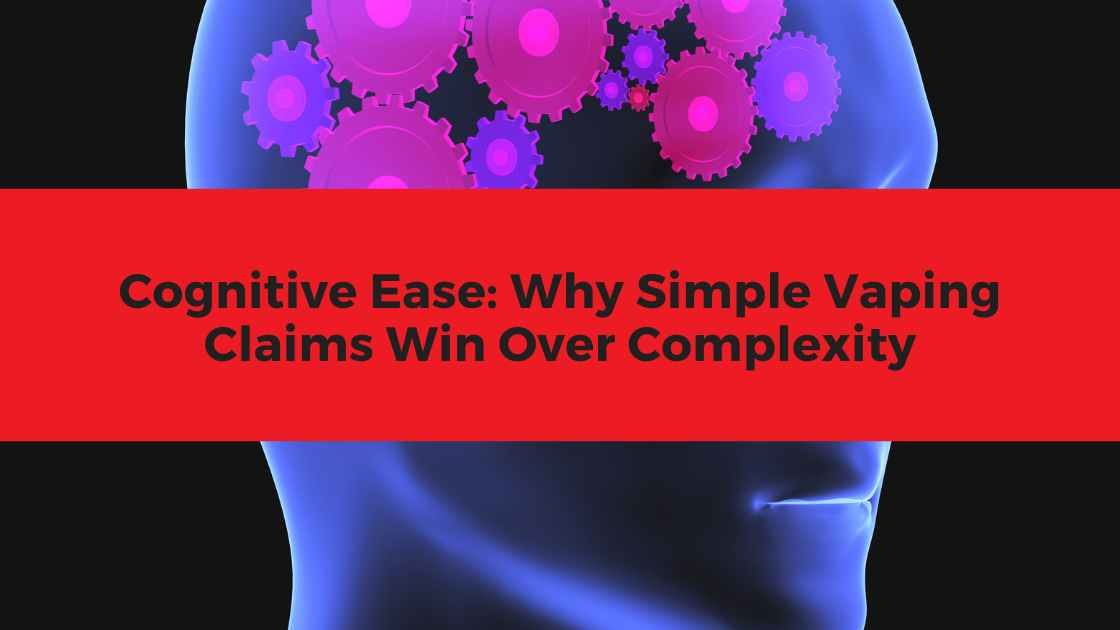Cognitive Ease: Why Simple Vaping Claims Win Over Complexity
When it comes to vaping, what feels true isn’t always necessarily true. You’ve probably seen short, scary, and convincing headlines such as, “Vaping causes lung disease.” These are made to grab your attention, but in reality, the headline should probably look something more like this: “Research suggests certain vaping conditions may increase risk factors for respiratory issues in some populations.”
Even though the second headline is more accurate, most people will tend to believe the first. Why? This is because it is easier to process through the psychological concept called ‘cognitive ease.’ Essentially, this is a mental shortcut that makes simple statements appear to be true, even when they aren’t.
Understanding Cognitive Ease
Cognitive ease is defined as the subjective experience of how easy or difficult it is to process information. When information is clear, familiar, or repeated, our brains automatically associate it with being more truthful, even when it may not be. Psychologist Daniel Kahneman explains this through two mental systems: System 1 includes fast, intuitive, and automatic reactions. Whereas system 2 includes slow, deliberate, and logical reactions.
Our brains are bombarded with so much information, we tend to rely on system 1 more frequently. The problem with this is that it creates an ‘illusion of understanding’ for complex topics, which is why simple statements such as “vaping is deadly” suddenly appear much more trustworthy.
The Vaping Information Environment
The topic of vaping is complex in its very nature, with scientists studying a wide range of issues such as the differences between devices and liquids. It is still an emerging field, and it is also multidisciplinary, with many differences in variation. This creates various nuances in vaping research, as there are so many avenues to explore in topics like dose dependence and long-term effects, comparison with smoking, and individual factors such as demographics.
These nuances are so broad that it is hard to condense them into a single headline, but this is exactly what the media, especially social media, tries to do. For example, the debunked idea that vaping causes ‘popcorn lung’ still circulates around the media frequently. This is because it is simple, scary, and shared often. These traits make it more memorable and attention grabbing to encourage more clicks. In contrast, real science in more cautious and harder to condense.
Factors that Increase Cognitive Ease
How our brains process information causes oversimplified vaping claims to stick in the following ways:
Repetition means that when we hear information often, it makes it feel true even when the science doesn’t support it. For example, as I mentioned earlier, ‘popcorn lung’ is still commonly linked to vaping despite it being debunked.
Simple language is a lot easier to grasp than detailed research about specific chemicals and doses, meaning simple headlines such as “Vaping is Toxic” will win over detailed explanations.
Visual clarity will mean that bold fonts and scary icons will draw people’s attention to the headline and make them believe it is truthful.
Familiarity will make people more likely to believe claims that fit their current perspective. An example of this is if someone already believes vaping is dangerous, they are much more likely to believe claims like “vaping causes cancer”.
The Impact on Vaping Perceptions
A 2024 study by University College London revealed there were considerable misconceptions about vaping, with 57% of smokers in England and 74% globally believing that vaping is more harmful than smoking. This is just one of the many common misconceptions about vaping which can have many negatives, including deterring smokers from switching to less harmful alternatives.
A Real-World Example
Another example includes the previously mentioned ‘popcorn lung’ myth which still exists in vaping discourse. It originally stemmed from concerns about the chemical diacetyl, yet most modern vaping products do not contain diacetyl, but the myth continues to this day. This gives you an idea about how vaping research is communicated in the media, and how the essential nuances are often lost, leading to oversimplified and often misleading claims.
Breaking the Ease = Truth Association
So how do we fight back against the misleading simplicity?
- Look out for nuances—more accurate claims will often include language such as “may” or “in some populations.”
- Embrace cognitive strain—if something feels a little harder to understand, it may mean that it might actually be more accurate.
- Seek out reliable sources—Don’t just rely on headlines alone; try to delve deeper into the topic by seeking out research or more detailed summaries.
- Take a pause before accepting claims as truthful—this will help you distinguish between something that may come from simplicity rather than accuracy.
How the Vaping Misinformation Detector Addresses Cognitive Ease Bias
The Vaping Misinformation Detector (VMD) bridges the gap between scientific complexity and practical understanding. Built specifically to address misinformation online, the tool features a tiered information design—offering clear summaries of misinformation claims with links that allow the user to explore the supporting evidence. This layered approach means everyone from concerned parents to health professionals can engage meaningfully with the content. By placing each claim within its broader research context, the VMD prevents isolated findings from being misinterpreted, ensuring users understand both the forest and the trees of vaping science.
Conclusion
Cognitive ease shapes how we perceive and understand vaping, but not always for the better. Our brains prefer simple and repeated messages, even if they are inaccurate and misleading; this is how myths and confusion about vaping spread. It is important to remember that feeling like we understand something doesn’t mean that you always do. This is where we need to learn to question what feels true by embracing the complexity and using tools such as the VMD to stay informed and reduce cognitive bias. So, the next time you come across a claim about vaping, pause and think, is it simple or is it true?
Guest article “Cognitive Ease: Why Simple Vaping Claims Win Over Complexity” by David Mullarkey



Comments are closed here.